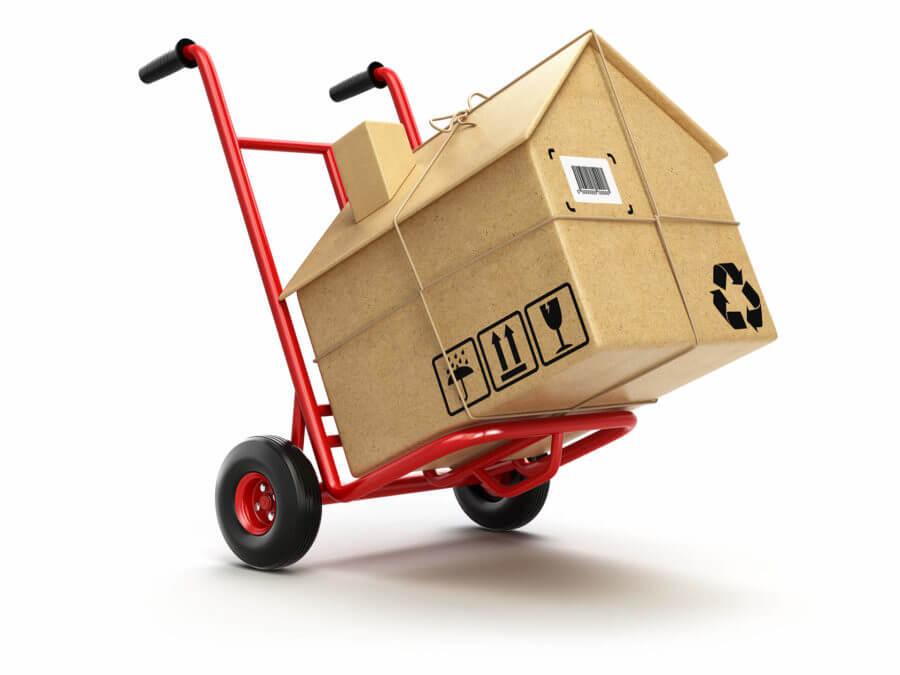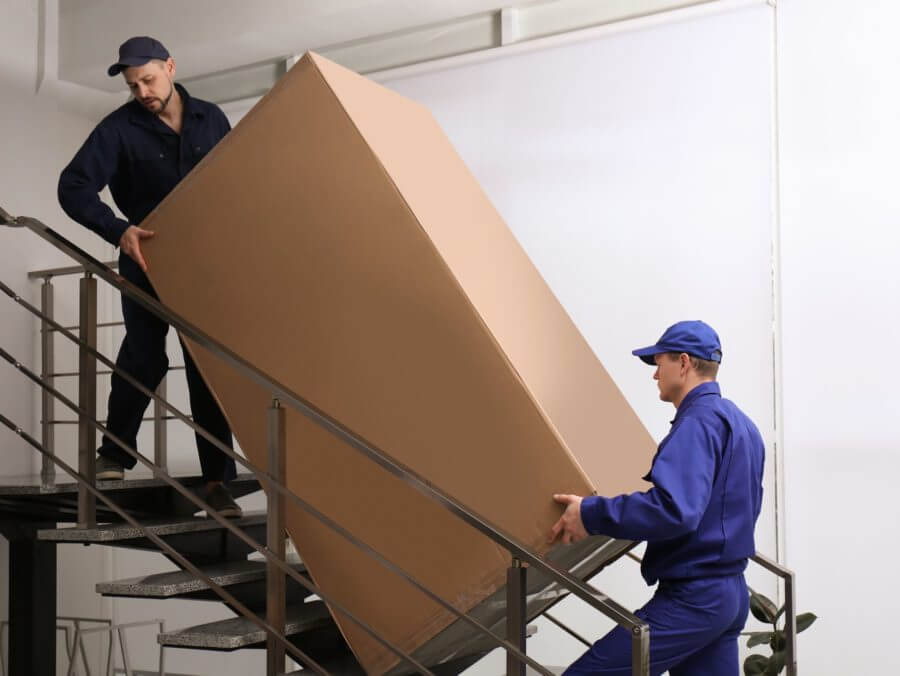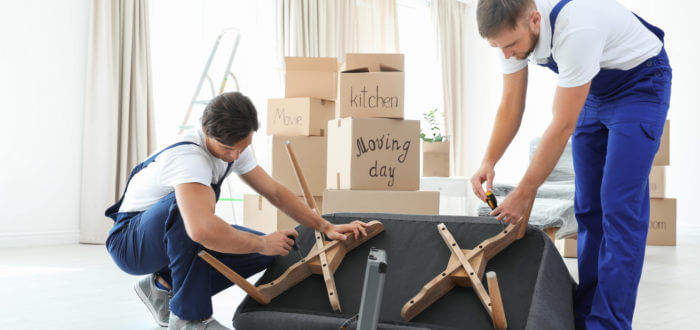

The Ultimate Guide – How to Move a Hot Tub Safely
Posted in How-to,Moving Tips & Tricks on October 10, 2023
Transporting a hot tub to your new home can be a daunting task, especially when moving cross country, but with the right knowledge and preparation, it can be a manageable and stress-free endeavor. So, let’s dive in and learn how to move a hot tub safely, making sure the prized hydrotherapy haven arrives at its new location intact and ready for your enjoyment.
Moving a jacuzzi entails careful planning and consideration. Typical hot tubs can weigh anywhere from 400 to 6,000 pounds, making professional assistance or a team of helpers crucial. Draining and disconnecting electrical components safely is essential, followed by proper cleaning. Specialized equipment, like spa dollies and protective blankets, is recommended. Secure transportation using the right vehicle and straps is key. Additionally, legal regulations, including permits and zoning laws, must be followed when relocating and installing a jacuzzi in a new location for a successful and compliant relocation.
Understand if You Can Actually Relocate the Hot Tub
Before embarking on the task of figuring out how to move a hot tub by yourself, it’s crucial to thoroughly understand if it is, in fact, movable in the first place. Start by assessing its dimensions and weight. Hot tubs come in various shapes and sizes, and some can be incredibly heavy, particularly when filled with water. Measure its width, length, and height, and calculate its weight when filled.
This information will help you determine if the intended destination can accommodate the spa and if you have the necessary equipment to transport it safely. Additionally, consider the materials it is made of and their vulnerability to stress during the relocation. Acrylic and fiberglass tubs, for example, can be more fragile than rotomolded or wooden ones, necessitating extra precautions during relocation. Understanding these aspects is the first step towards successful and damage-free transport.
Necessary Tools and Equipment
When preparing to move a hot tub, having the necessary tools and equipment at your disposal is paramount to ensure a smooth and safe relocation. First and foremost, a spa dolly or cart is an essential item – these specialized devices are designed to support the weight and shape of hot tubs, making them easier to move. Furniture dollies can also prove invaluable, aiding in maneuvering the spa over uneven terrain or through tight spaces.
To prevent shifting or tipping during transport, appliance straps or relocation straps are indispensable for securing the jacuzzi to the dolly or cart securely. Protecting the jacuzzi’s delicate surface is crucial, so be sure to have a supply of protective blankets or pads on hand.
Additionally, consider using plywood to create a smooth path, especially if you need to traverse uneven terrain or steps, as it will help distribute the weight evenly and prevent damage to both the tub and the ground underneath. These tools and equipment are essential components of a successful relocation, ensuring both the safety of the spa and the ease of the relocation process.

How to Move a Hot Tub – Step-by-Step Instructions
Relocating hot tubs requires careful planning and execution to ensure both the safety of the spa and the individuals involved in the process. Follow these step-by-step instructions for a smooth and successful relocation.
Draining the Hot Tub
Before you begin the process of moving a jacuzzi, it’s crucial to drain it completely. Start by turning off the power to the spa and shutting down the heating and filtration systems. Then, follow a step-by-step draining process to ensure the tub is empty. Typically, this involves attaching a garden hose to the spa’s drainage port and allowing gravity to drain the water.
Depending on the size of the tub, this may take several hours. Once it’s drained, be sure to dispose of the water responsibly, as it may contain chemicals that are harmful to the environment. Avoid draining it directly into storm drains and instead opt for methods like irrigating the lawn or contacting a local water disposal service. Watch this video if you need more help on how to drain a hot tub.
Disconnecting Electrical Components
Safety is paramount when dealing with electrical components. Start by turning off the power at the breaker panel to ensure there’s no risk of electrical shock. Afterward, carefully disconnect all electrical components, including the control panel, heating elements, and any other electrical connections.
Store these components in a dry and secure place to protect them during the relocation. Properly coiling and labeling wires can be immensely helpful when it’s time to reconnect everything once in the new home. Taking these precautions will help ensure the safety of both the jacuzzi and anyone involved in the relocation process.
Cleaning and Drying
Cleaning the jacuzzi before moving it is a crucial step often overlooked. Remove any debris, dirt, or residue from both the interior and exterior of the spa. This not only prevents any potential contamination but also ensures that the shell remains in good condition. Equally important is making sure the spa is completely dry. Any remaining moisture can lead to mold and mildew growth during transportation or storage.
Use towels, fans, or even a wet-dry vacuum to remove any moisture, and be thorough in this step to avoid potential damage to the spa and maintain its overall hygiene. By draining, disconnecting, cleaning, and drying the jacuzzi properly, you’re setting the stage for a successful and stress-free relocation.

Enlisting Help From Cross Country Movers
When it comes to relocating hot tubs across the country, hiring long-distance movers can be a game-changer. These experts have the experience and equipment necessary to handle the intricate logistics of long-distance moving safely and efficiently. Their cross-country moving services typically include not only the physical transportation of the spa but also comprehensive planning, packing services, and securing the jacuzzi for the journey in the relocation truck.
By partnering with cross-country movers and choosing a reliable relocation company, you can alleviate much of the relocation stress and physical labor associated with this complex task, ensuring that your belongings arrive at their destination in pristine condition. Communicate freely with the movers and ask them any questions you may have, such as how much does it cost to move a hot tub, so you can factor that in the relocation budget.
Use a Variety of Other Cross Country Moving Services
In addition to the expertise of cross-country movers, consider leveraging a variety of other relocation services to further streamline the relocation. This might include specialized crating or packaging services that provide extra protection for the spa during transit. Additionally, inquire about insurance options to safeguard the investment in case of any unforeseen accidents, damages, or any other relocation mistakes.
Some companies even offer climate-controlled transportation, ensuring that the jacuzzi is exposed to optimal conditions throughout its journey. By exploring these supplementary services, you can tailor the relocation to meet your specific needs and ensure the utmost care for the cherished jacuzzi.

Setting Up at the New Location
Setting up the jacuzzi once all else is done is the final and exciting step in the relocation process. To ensure a successful installation, start by choosing the right spot. Consider factors such as drainage, power sources, and aesthetics. Ensure that the area has proper drainage to avoid water pooling around the hot tub. Additionally, confirm that you have easy access to a power source and that it meets the spa’s electrical requirements. Finally, think about the aesthetics of the location, as it should complement your outdoor space and provide a relaxing ambiance.
Next, connect the electrical components carefully. Refer to the moving labels or photographs you took when disconnecting them earlier to ensure proper reassembly. Prioritize safety by having a qualified electrician inspect and verify the electrical connections.
Finally, refill the jacuzzi. Use a garden hose to fill it with fresh water. Take time to ensure that the water level is correct, and check the spa’s filtration and heating systems to ensure they are functioning properly. Once it’s filled and the water is at the desired temperature, you can finally enjoy the rejuvenating oasis in its new and carefully chosen location.

Safety Tips to Remember
When relocating a jacuzzi, safety should be a top priority to prevent injuries and ensure a smooth and efficient relocation process. First and foremost, employ proper lifting techniques to avoid injuries. Always lift with the legs, not the back, and use your core muscles to support the weight. Enlist the help of others, as tubs can be exceptionally heavy, and teamwork can minimize the risk of strain or accidents.
Taking breaks and not rushing is equally vital. Moving a jacuzzi is a physically demanding task, so don’t hesitate to pause and rest when needed. Rushing can lead to mistakes and increase the likelihood of accidents. Plan for breaks and stay hydrated to maintain energy and focus throughout the relocation.
Lastly, consider using gloves for better grip. Hot tub surfaces can be slippery, especially when wet, and gloves provide additional traction, reducing the risk of dropping or losing control of the spa. By adhering to these safety relocation tips, you’ll not only protect yourself and your team but also ensure a successful and injury-free spa relocation.

Navigating the Challenge of Moving the Hot Tub Can Be Even Easier
In conclusion, moving a jacuzzi safely and successfully requires careful planning, the right tools, and a commitment to prioritizing safety. From draining and disconnecting to cleaning and drying, each step of the process plays a crucial role in ensuring the spa’s well-being during the relocation. Enlisting the assistance of cross-country movers and utilizing various services can make the daunting task of relocating the jacuzzi a far less arduous endeavor. So, contact us, and Cross Country Movers will make sure your precious tub is moved safely and hassle-free.
FAQ
How Much Does a Typical Hot Tub Weigh?
The weight can vary considerably depending on its size, material, and the amount of water it holds. On average, an empty tub can weigh between 400 to 900 pounds. When filled with water, they can weigh anywhere from 2,000 to 6,000 pounds. Therefore, it’s essential to know the specific weight of the jacuzzi before relocating it, as this information will determine the type of equipment and number of people needed for a safe relocation.
Can I Move a Hot Tub by Myself?
While it’s technically possible to relocate a small, empty jacuzzi by yourself, it is not advisable. The weight and size of tubs make them challenging to handle alone, and attempting to do so can lead to serious injuries or damage to the spa. It’s strongly recommended to enlist the help of others or hire professional movers.
How Many People Are Typically Required to Move a Hot Tub?
The number of people needed to relocate a jacuzzi depends on its size and weight. Generally, for smaller tubs, two to four strong individuals may suffice. Larger tubs may require a team of four or more people. Additionally, specialized equipment like spa dollies or carts can reduce the number of required movers by assisting with the heavy lifting.
What’s the Best Way to Drain My Hot Tub Before Moving?
To drain a jacuzzi before relocating it, start by turning off the power to the spa. Attach a garden hose to the drainage port, open the drain valve, and let gravity do the work. This method is the most common and efficient way to empty the spa. Ensure the water is drained responsibly, avoiding harm to the environment.
How Do I Disconnect the Electrical Components Safely?
Disconnecting electrical components safely begins with turning off the power at the breaker panel to prevent electrical shock hazards. Next, carefully disconnect all electrical connections, including the control panel, heating elements, and any other wiring. Label or photograph the wires for reference during reassembly. It’s advisable to have a qualified electrician inspect and verify the electrical connections for safety when setting up at the new location.
Is It Necessary to Clean My Hot Tub Before Moving It?
Cleaning the jacuzzi before relocating is essential. Remove any debris, dirt, or residue from both the interior and exterior of the spa. Cleaning not only prevents contamination during transportation but also helps maintain the condition and hygiene.
Do I Need Specialized Equipment or Can I Use Items From Home?
Specialized equipment such as spa dollies, furniture dollies, appliance straps, and protective blankets are crucial for a safe jacuzzi move. While you might use some common household items, like plywood, for creating a smooth moving path, it’s highly recommended to invest in or rent specialized equipment designed for jacuzzi relocation. Using proper tools minimizes the risk of damage and ensures a smoother process.
How Do I Protect My Hot Tub From Scratches and Dents During the Relocation?
To protect the spa from scratches and dents, wrap it in protective blankets or pads. These cushions act as a buffer between the spa’s surface and any potential impact or friction during transport. Additionally, using furniture dollies with soft, non-abrasive wheels can help prevent damage to the exterior.
What Type of Vehicle Is Best for Transporting a Hot Tub?
The best vehicle for transporting a jacuzzi depends on the spa’s size and weight. A flatbed trailer or specialized trailer is often the preferred choice, as it provides ample space and stability.
How Do I Ensure the Hot Tub Doesn’t Shift or Move During Transit?
To prevent the jacuzzi from shifting during transit, secure it to the trailer or truck using strong and reliable straps. Utilize ratchet straps or moving straps to fasten the spa securely in multiple directions. Distribute the straps evenly to maintain balance and minimize the risk of shifting during transport.
Are There Any Legal Considerations or Restrictions When Moving and Installing a Hot Tub in a New Location?
Yes, there can be legal considerations and restrictions when moving and installing hot tubs. Local zoning laws, building codes, and homeowner association regulations may dictate where and how you can place the spa. It’s crucial to research and adhere to these guidelines to avoid potential legal issues.






